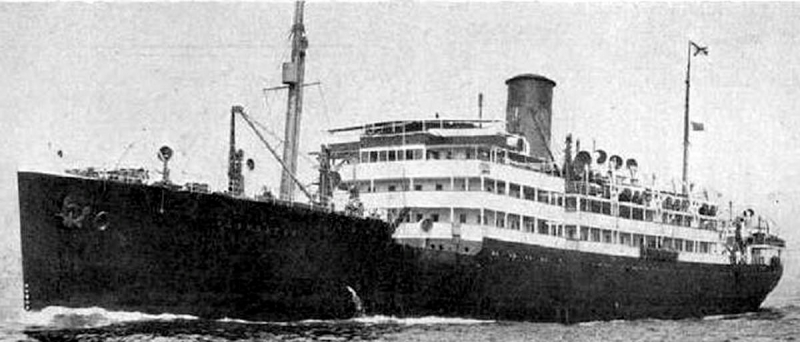ARMATORI DEL PRESENTE - Armatori C - CSAV Casilla 49-V, Plaza Sotomayor 50, 2360171 Valparaiso, Chile.
| Precedente Successiva |
 |
| Aconcagua |
| Class: LR Renamed: Khedive Ismail Type of ship: Passengers and Cargo Ship. Call Sign: HBLP Flag: Chile. Port of Register: Valparaiso Ship?s Owners: Cia. Sudamericana de Vapores. Passengers capacity: First Class: 155 Third Class: 88 GRT: 7.309 NRT: 3.975 LOA: 130,45 Mts. B: 17,05 Mts. D: 9,45 Mts. Ship?s Yard: Scott Shipbuilding &Engineering Co. Ltd., of Greenock, Scotland.. Hull N?: 516 Date of Launch: 11 February 1922 Delivery date: 18 September 1922 Four Brown Curtis steam turbines, with two axles simple reduction. Boilers: 215 lbs. 7.500 CV. Propellers: 2 Speed: 17,5 Knots. Sank at Addu Atol on 12 February 1944 by torpedo with a loss of over 1200 lives. (https://rankly.com/item/sinking-of-the-ss-khedive-ismail-1) As per http://www.ssarkansan.com/home/american-hawaiian-in-wwii/montanan On February 5th, 1944 the troop convoy KR.8 departed the port of Kilindini, Mobassa, Kenya bound for Colombo, Ceylon. The convoy was comprised of: SS City of Paris (10,902 tons) SS Ekma (5,108 tons) SS Ellenga (5,196 tons) SS Khedive Ismail (7,290 tons) SS Varsova (4,701 tons) The five transports were carrying a total of 6,311 Army troops, Royal Navy personnel, medical staff, and members of the Women's Territorial Service (WTS). The convoy escort out of Kilindini was provided by the old heavy cruiser HMS Hawkins (D 86), the flower class corvette HMS Honesty (K 285), and two Banff class sloops, HMS Sennen (Y 21) and HMS Lulworth (Y 60). HMS Hawkins was nearing the end of its usefulness, was reportedly not even equipped with anti-submarine gear, and to put it bluntly, was more of a target than a deterrent. At some point on their voyage up the east coast of Africa, the corvette and sloops were relieved by the destroyers HMS Paladin (G 69) and HMS Petard (G 56), probably before the convoy turned east to transit the Arabian Sea. A third destroyer, HMS Penn (G 77) was intended, but could not take part as she was still under repair. On February 12th, 1944, the I-27 sighted the convoy moving towards them at 13 knots about 60 miles southwest of the One and a Half Degree Channel, and submerged to attack. According to Admiralty reports: ?Convoy included HAWKINS and 5 ships in 3 columns [so only two rows deep]. 3 cables apart 13 knots no zigzag. PALADIN and PETARD about 45? on bows of convoy carrying out broad zigzag.? According to combinedfleet.com: ?Fukumura closes in from ahead to attack, probably intending to target heavy cruiser HAWKINS, the leader of the port column, from the starboard quarter of the convoy. He dives under the screening destroyers without being detected and raises his periscope for a snap shot only 50 yards astern of VARSOVA, the leading ship of the starboard column. Fukumura then fires a spread of four torpedoes at the cruiser, partially overlapped by KHEDIVE ISMAIL (Capt Roderick C. Whiteman), the leading ship of the center column.? ?Three gunners on the stern gun platform of VARSOVA sight a dark green periscope protruding some 3 ft above the water and traveling towards KHEDIVE ISMAIL at 4 kts. They attempt to target it, but their gun cannot be depressed deep enough.? ?At 1433 (convoy time), KHEDIVE ISMAIL receives a torpedo hit to her starboard side engine room and starts to list to starboard. The aft mast collapses and the adjacent superstructure caves in, while the after hatch covers are blown upwards. Approximately 5 seconds later the second torpedo strikes the boiler room forward, directly below the ship's funnel, causing a major explosion inside the ship.? ?Once on her beam ends, KHEDIVE ISMAIL breaks in two; the stern sinks first, the bow upends and then corkscrews beneath the surface only one minute and 40 seconds after the first hit, at 00-57N, 72-16E. Of 1,511 passengers and crew 1,279 are lost, including a total of 77 women.? The large number of female casualties, the largest in the war, was especially tragic. The sinking in general was the 3rd highest loss of life for a British troopship during the war (the others being 1) Lancastria with 4,000+ souls lost and 2) Laconia with 1,658 souls lost). ?Two remaining torpedoes, one of them a surface runner, pass ahead and astern of HMS HAWKINS, forcing her to take evasive action. The two destroyers each turn 180 degrees outwards while the convoy scatters, to regroup at 02-41N, 74-49E.? ?Multiple periscope sightings are reported by different vessels and confusion ensues. At 1436 Lt Edward A.S. Bailey's HMS PALADIN first establishes an asdic (sonar) contact N of the position of the now-sunken KHEDIVE ISMAIL, dropping a pattern of ten depth charges near the stern of the retreating HMS HAWKINS. PALADIN then chases a false contact and at 1449 drops a single depth charge at a periscope detected by the steamer CITY OF PARIS. PALADIN's next attack with ten depth charges against an unreliable target fails, but then a new contact is detected. After her asdic operator reports hearing a noise resembling the blowing of ballast tanks, nine depth charges are dropped at 1502.? ?Commander Rupert C. Egan's HMS PETARD likewise chases several contacts about a mile SW of the sinking. The first target is lost during the approach. At 1500, PETARD drops a pattern of seven depth charges, followed by eight depth charges five minutes later. After the final attack with nine depth charges at 1513, this contact is lost. Following an unsuccessful sweep to the westward, at 1536 Cdr Egan gives permission to pick up the survivors from KHEDIVE ISMAIL.? Adding to the tragedy, Petard made at least one depth charge run through the survivors, the safety of the rest of the convoy taking precedence over that of survivors. Fukumura was alleged to have been hiding under the survivors, but there is no hard evidence of this. Fukumura was likely more pre-occupied with trying to slowly maneuver away from the escorts. In all his former attacks except the Alcoa Prospector (convoy PA-44) he was fortunate to have found vessels traveling independently, and may have never faced the terror of concerted depth charge attacks by formidable escorts, as frantic and disorganized as the counter-attack initially was. Japanese defensive doctrine would have called for I-27 to move only when the escorts moved and at slow speed to limit the possibility of detection. As I-27 was already within the convoy perimeter and the Khedive Ismail sank so rapidly, they were naturally within close proximity to the survivors. Assuming he was using them as some sort of human shield is just that, an assumption only. |
| Username | |
| Armatore | CSAV. Compa??a Sudamericana de Vapores |
| Ship manager | |
| Numero IMO | |
| Classificazione | Passengers and Cargo Ship |
| Cantiere e anno di costruzione | 1922 Scott Shipbuilding &Engineering Co. Ltd. |
| Data | |
| Luogo | |
| Aggiunta il | 13/05/2016 |
| Dimensioni | 1200 x 512 |
| visite | 1716 |
















